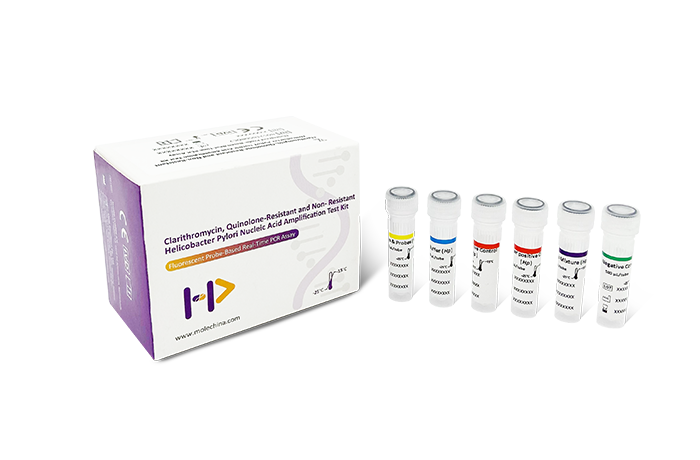




Helicobacter pylori infection is a common worldwide infection, and about 50% of the world's population were infected with H. pylori. H. pylori is an important cause of gastrointestinal digestive system-related diseases, such as chronic gastritis, stomach ulcers, duodenum ulcers and gastric cancer etc.
Currently, the treatment regimen for H. pylori in clinical is triple or quadruple therapy consisting of antibiotics and PPI. The overuse and misuse of antibiotics have led to H. pylori resistance to antibiotics; therefore, the detection of H. pylori and its resistance is important for guiding of clinical treatments of H. pylori Infection.
The shelf life of this kit is 12 months when stored in freezer at -(20±5) °C.
Limit of detection
When the sample concentration is too low (≤10copies/μL ),100% positive results cannot be reached in every test within 20 repeated amplification.
Precision
The within-run precision CV is ≤5%; The between-run precision CV is ≤5%.
Analytical Specificity
Cross-Reactivity: There are no cross-reactivities with the other pathogenic microorganisms in the gastrointestinal tract such as: Bacillus cereus, Klebsiella pneumoniae, Staphylococcus aureus, Streptococcus pneumoniae, Plesiomonas shigelloides, Haemophilus influenzae, Vibrio parahaemolyticus, Salmonella, Pseudomonas aeruginosa, Meningococcus, Mycobacterium tuberculosis, Escherichia coli, etc.
Interference substances: When common interfering substances, such as the blood concentration reach to 3%, there is no effect on sample test results.
Medication effects: When the test sample contains drugs at the following concentration, it will not affect the test results of the samples: Amoxicillin 0.75mg.L-1; Clarithromycin 0.29mg.L-1; Levofloxacin 1.62mg.L-1; Omeprazole 0.4mg.L-1; Bismuth Potassium Citrate 67.85mg.L-1
Limit of detection of mutation
When H. pylori DNA concentration is 1pg/μL, the mutant abundances is ≥0.1%, the resistant strain can be identified by using this kit; When H. pylori DNA concentration is 0.001pg/μL, the mutant abundances is ≥50%, the resistant strain can be identified by using this test.
Due to the extensive use of antibiotics, H.pylori resistance strains are widespread; The Maastricht V/Florence Consensus Report recommended performing clarithromycin sus-ceptibility testing by the molecular test directly on the gastric biopsy specimen.
Anti-contamination: UNG/dUTP system minimizing the PCR contamination.
Fast Detection: Analysis time within 2 hours.
Reliable Results: Internal control included in each tube monitoring whole testing processes and avoid false-negative results.
3 in 1 Detection: Detects wild H. pylori, Clarithromycin and Quinolone antibiot-ic-resistant simulta-neously in a single tube
About 50% of people in the world have a history of Helicobacter Pylori infection; The Maas-tricht V/Florence Consensus Report pointed out “H. pylori infection is accepted as the major aetiological factor for gastric cancer, and H. pylori eradication reduces the risk of gastric cancer development.”